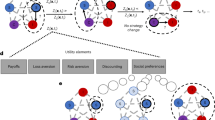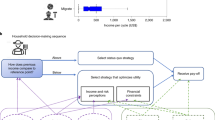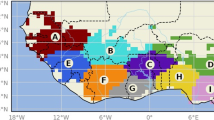Abstract
Extreme weather events often prevent low-income farmers from accessing high-return technologies that would enhance their productivity. As a result, they often fall into poverty traps, a problem likely to worsen as the frequency of weather disasters increases due to climate change. Insurance offers, in principle, a solution for this conundrum and a means to guarantee households’ wellbeing. Group collective index insurance constitutes an alternative to indemnity or individual index insurance, and has the potential to alleviate basis risk through within-group informal transfers. Here we show that collective index insurance introduces a coordination dilemma of insurance adoption: socially optimal outcomes are obtained when everyone adopts insurance; however, a minimum fraction of contributors is necessary before the effects of basis risk can be averaged out and individuals start taking up insurance. We further show that additional mechanisms—such as local peer monitoring and defector exclusion—are necessary to stabilize informal transfers and collective index insurance adoption. Together, collective index insurance and informal transfers may thus constitute a practical instrument to improve sustainability in developing countries.
This is a preview of subscription content, access via your institution
Access options
Access Nature and 54 other Nature Portfolio journals
Get Nature+, our best-value online-access subscription
$29.99 / 30 days
cancel any time
Subscribe to this journal
Receive 12 digital issues and online access to articles
$119.00 per year
only $9.92 per issue
Buy this article
- Purchase on Springer Link
- Instant access to full article PDF
Prices may be subject to local taxes which are calculated during checkout




Similar content being viewed by others
Data availability
Source data are provided with this paper.
Code availability
This paper relies on theoretical results following direct implementation of the equations provided in the Methods. Further details are provided in the Supplementary Information.
References
Clarke, D. J. & Dercon, S. Dull Disasters? How Planning Ahead will Make a Difference (Oxford Univ. Press, 2016).
The Impact of Natural Hazards and Disasters on Agriculture and Food Security and Nutrition: A Call for Action to Build Resilient Livelihoods (FAO, 2015); http://www.fao.org/3/a-i4434e.pdf
Hallegatte, S. et al. Shock Waves: Managing the Impacts of Climate Change on Poverty (The World Bank, 2015).
Schaefer, L. & Waters, E. Climate Risk Insurance for The Poor & Vulnerable: How to Effectivelly Implement the Pro-Poor Focus of Insuresilience (Munich Climate Insurance Initiative, 2016).
Panda, A., Lambert, P. & Surminski, S. Insurance and Financial Services Across Developing Countries: An Empirical Study of Coverage and Demand Centre for Climate Change Economics and Policy Working Paper 367 & Grantham Research Institute on Climate Change and the Environment Working Paper 336 (London School of Economics and Political Science, 2020).
Cottrell, R. S. et al. Food production shocks across land and sea. Nat. Sustain. 2, 130–137 (2019).
Barnett, B. J. & Mahul, O. Weather index insurance for agriculture and rural areas in lower-income countries. Am. J. Agric. Econ. 89, 1241–1247 (2007).
Hansen, J. et al. Climate risk management and rural poverty reduction. Agric. Syst. 172, 28–46 (2019).
Barnett, B. J., Barrett, C. B. & Skees, J. R. Poverty traps and index-based risk transfer products. World Dev. 36, 1766–1785 (2008).
Noritomo, Y. & Takahashi, Y. Can insurance payouts prevent a poverty trap? Evidence from randomised experiments in northern Kenya. J. Dev, Stud. 56, 2079–2096 (2020).
Janzen, S. A. & Carter, M. R. After the drought: The impact of microinsurance on consumption smoothing and asset protection. Am. J. Agric. Econ. 101, 651–671 (2019).
Hazell, P. B. & Hess, U. Drought insurance for agricultural development and food security in dryland areas. Food Secur. 2, 395–405 (2010).
Transforming Our World: The 2030 Agenda for Sustainable Development (United Nations, 2015).
Carter, M., de Janvry, A., Sadoulet, E. & Sarris, A. Index insurance for developing country agriculture: a reassessment. Annu. Rev. Resour. Econ. 9, 421–438 (2017).
Binswanger-Mkhize, H. P. Is there too much hype about index-based agricultural insurance? J. Dev. Stud. 48, 187–200 (2012).
Clarke, D. J. A theory of rational demand for index insurance. Am. Econ. J. Microecon. 8, 283–306 (2016).
Budhathoki, N. K., Lassa, J. A., Pun, S. & Zander, K. K. Farmers’ interest and willingness-to-pay for index-based crop insurance in the lowlands of Nepal. Land Use Policy 85, 1–10 (2019).
Sibiko, K. W., Veettil, P. C. & Qaim, M. Small farmers’ preferences for weather index insurance: insights from Kenya. Agric. Food Secur. 7, 53 (2018).
Trærup, S. L. Informal networks and resilience to climate change impacts: a collective approach to index insurance. Glob. Environ. Change 22, 255–267 (2012).
Pacheco, J. M., Santos, F. C. & Levin, S. A. Evolutionary dynamics of collective index insurance. J. Math. Biol. 72, 997–1010 (2016).
Dercon, S., Hill, R. V., Clarke, D., Outes-Leon, I. & Taffesse, A. S. Offering rainfall insurance to informal insurance groups: evidence from a field experiment in Ethiopia. J. Dev. Econ. 106, 132–143 (2014).
De Janvry, A., Dequiedt, V. & Sadoulet, E. The demand for insurance against common shocks. J. Dev. Econ. 106, 227–238 (2014).
Dercon, S., De Weerdt, J., Bold, T. & Pankhurst, A. Group-based funeral insurance in Ethiopia and Tanzania. World Dev. 34, 685–703 (2006).
Mobarak, A. M. & Rosenzweig, M. R. Selling Formal Insurance to the Informally Insured Working Paper (Yale Univ., 2012).
Arnott, R. & Stiglitz, J. E. Moral hazard and nonmarket institutions: dysfunctional crowding out of peer monitoring? Am. Econ. Rev 81, 179–190 (1991).
Takahashi, K., Barrett, C. B. & Ikegami, M. Does index insurance crowd in or crowd out informal risk sharing? Evidence from rural Ethiopia. Am. J. Agric. Econ. 101, 672–691 (2019).
Mobarak, A. M. & Rosenzweig, M. R. Informal risk sharing, index insurance, and risk taking in developing countries. Am. Econ. Rev. 103, 375–380 (2013).
Kunreuther, H. C. & Michel-Kerjan, E. O. At War With the Weather: Managing Large-Scale Risks in a New Era of Catastrophes (MIT Press, 2011).
van Valkengoed, A. M. & Steg, L. Meta-analyses of factors motivating climate change adaptation behaviour. Nat. Clim. Change 9, 158–163 (2019).
Lo, A. Y. The role of social norms in climate adaptation: mediating risk perception and flood insurance purchase. Glob. Environ. Change 23, 1249–1257 (2013).
Cai, J., De Janvry, A. & Sadoulet, E. Social networks and the decision to insure. Am. Econ. J. 7, 81–108 (2015).
Cole, S. et al. Barriers to household risk management: Evidence from India. Am. Econ. J. 5, 104–135 (2013).
Dixit, A. K., Levin, S. A. & Rubenstein, D. I. Reciprocal insurance among Kenyan pastoralists. Theor. Ecol. 6, 173–187 (2013).
Hilbe, C., Chatterjee, K. & Nowak, M. A. Partners and rivals in direct reciprocity. Nat. Hum. Behav. 2, 469–477 (2018).
Molho, C., Tybur, J. M., Van Lange, P. A. & Balliet, D. Direct and indirect punishment of norm violations in daily life. Nat. Commun. 11, 3432 (2020).
Tilman, A. R., Levin, S. & Watson, J. R. Revenue-sharing clubs provide economic insurance and incentives for sustainability in common-pool resource systems. J. Theor. Biol. 454, 205–214 (2018).
Mwenda, E. R. Mongolia—Index-Based Livestock Insurance Project Policy Research Working Paper Series 3528 (The World Bank, 2012).
Arrow, K. J. Uncertainty and the welfare economics of medical care. Am. Econ. Rev. 53, 941–973 (1963).
Why wait for death? How a Ugandan hospital delivers health insurance through burial groups. The Economist (30 January 2020); https://go.nature.com/33Zvazv
Góis, A. R., Santos, F. P., Pacheco, J. M. & Santos, F. C. Reward and punishment in climate change dilemmas. Sci. Rep. 9, 16193 (2019).
Santos, F. P., Santos, F. C. & Pacheco, J. M. Social norm complexity and past reputations in the evolution of cooperation. Nature 555, 242–245 (2018).
Dixit, A. & Levin, S. in The Theory of Externalities and Public Goods (eds Buchholz, W. & Rübbelke, D.) 127–143 (Springer, 2017).
Tilman, A. R., Dixit, A. K. & Levin, S. A. Localized prosocial preferences, public goods, and common-pool resources. Proc. Natl Acad. Sci. USA 116, 5305–5310 (2019).
Molina, C., Akçay, E., Dieckmann, U., Levin, S. A. & Rovenskaya, E. A. Combating climate change with matching-commitment agreements. Sci. Rep. 10, 10251 (2020).
Wang, Z. et al. Communicating sentiment and outlook reverses inaction against collective risks. Proc. Natl Acad. Sci. USA 117, 17650–17655 (2020).
Carattini, S., Levin, S. & Tavoni, A. Cooperation in the climate commons. Rev. Environ. Econ. Policy 13, 227–247 (2019).
Nyborg, K. et al. Social norms as solutions. Science 354, 42–43 (2016).
Pratt, J. W. Risk aversion in the small and in the large. Econometrica 32, 122–136 (1964).
Arrow, K. J. Aspects of the Theory of Risk-Bearing (Yrjö Jahnssonin Säätiö, 1965).
Traulsen, A., Nowak, M. A. & Pacheco, J. M. Stochastic dynamics of invasion and fixation. Phys. Rev. E 74, 011909 (2006).
Acknowledgements
F.P.S. acknowledges support from the James S. McDonnell Foundation 21st Century Science Initiative in Understanding Dynamic and Multi-scale Systems Postdoctoral Fellowship Award. J.M.P. and F.C.S. acknowledge the support from FCT-Portugal (grants PTDC/MAT/STA/3358/2014, PTDC/MAT-APL/6804/2020, UIDB/04050/2020, UIDB/50021/2020 and PTDC/CCI-INF/7366/2020). S.A.L. acknowledges funding from the Army Research Office grant no. W911NF-18-1-0325. F.P.S. thanks J. A. Swan and the Princeton University WRI 503 Spring 2020 participants for discussions on the text of this manuscript.
Author information
Authors and Affiliations
Contributions
F.P.S., J.M.P., F.C.S. and S.A.L. conceived and designed the project. F.P.S. performed the numerical calculations and analysed the results. F.P.S., J.M.P., F.C.S. and S.A.L. discussed the results. F.P.S., J.M.P., F.C.S. and S.A.L. wrote and edited the manuscript.
Corresponding authors
Ethics declarations
Competing interests
The authors declare no competing interests.
Additional information
Peer review information Nature Sustainability thanks Yichao Zhang and the other, anonymous, reviewer(s) for their contribution to the peer review of this work.
Publisher’s note Springer Nature remains neutral with regard to jurisdictional claims in published maps and institutional affiliations.
Extended data
Extended Data Fig. 1 Effect of basis risk and risk-aversion in CII dynamics.
In the absence of risk-sharing pools (δ = 0) adoption of index insurance depends on the risk-aversion (γ) of individuals. a, As we consider an actuarially unfair insurance (from the consumer point of view, that is, qαw < c) only risk-averse individuals (high γ) adopt index insurance, which is evident by the positive gradients of selection for high γ. b, If basis risk is high, however, individuals do not adopt index insurance, which is evident by the negative gradients, implying a relative high probability of adopting No-CII compared with CII-C. c, The high rates of adoption of index insurance when the population is composed of risk-averse individuals is here evident by the peak in the stationary distribution over states with a high prevalence of CII-C individuals, when γ is high. d, Conversely, for high basis risk there is a peak in the stationary distribution over states with a high prevalence of No-CII, regardless of γ. Please note that, since δ = 0, strategies CII-C and CII-D are equivalent in this context. Other parameters: \(N = 1,w = 1,c = 0.18,p = q = 0.2,\alpha = 0.8,\beta = 10,Z = 100,\mu = 0.01\).
Extended Data Fig. 2 Effect of group size in CII dynamics.
The existence of sizeable groups in which individuals take part in informal risk-sharing (contributing to a common pool when they receive a payout without suffering a loss) promotes the adoption of index insurance. a, Sufficiently large groups introduce a coordination: if the number of individuals in the population goes above a critical fraction, the population will most likely evolve to a state where everyone adopts CII. b, If the basin of attraction towards CII is sufficiently large, we observe a high prevalence of individuals adopting CII, resulting in high index insurance take-up rates. Here we consider the prevalence of CII-C when only CII-C and No-CII can exist in a population. Other parameters: \(r = 0.1,w = 1,c = 0.18,p = q = 0.2,\alpha = 0.8,\delta = 0.5,\)\(\beta = 10,Z = 100,\mu = 0.01\).
Extended Data Fig. 3 The dilemma of CII adoption (and the need of peer-monitoring to solve it) in the context of less destructive events (lower values of α).
As in Figure 3 (main text) in all scenarios explored above the socially optimum outcome is achieved when all individuals adopt CII-C. In the absence of peer-monitoring (panels a and c) the most prevalent configurations are, however, those where individuals refuse insurance. The existence of peer-monitoring and defector exclusion from the informal pool (panels b and d) confers CII-C the relative advantage to be evolutionary robust. Other parameters: \(r = 0.1,w = 1,p = q = 0.2,\delta = 0.5,\beta = 50,Z = 50,N = 40,\mu = 0.02\).
Supplementary information
Supplementary Information
Supplementary Figs. 1–3, Table 1 and Notes.
Source data
Source Data Fig. 1
Raw data corresponding to plots represented.
Source Data Fig. 2
Raw data corresponding to plots represented.
Source Data Fig. 3
Raw data corresponding to plots represented.
Source Data Fig. 4
Raw data corresponding to plots represented.
Source Data Extended Data Fig. 1
Raw data corresponding to plots represented.
Source Data Extended Data Fig. 2
Raw data corresponding to plots represented.
Source Data Extended Data Fig. 3
Raw data corresponding to plots represented.
Rights and permissions
About this article
Cite this article
Santos, F.P., Pacheco, J.M., Santos, F.C. et al. Dynamics of informal risk sharing in collective index insurance. Nat Sustain 4, 426–432 (2021). https://doi.org/10.1038/s41893-020-00667-2
Received:
Accepted:
Published:
Issue Date:
DOI: https://doi.org/10.1038/s41893-020-00667-2
This article is cited by
-
Prosocial preferences improve climate risk management in subsistence farming communities
Nature Sustainability (2024)



